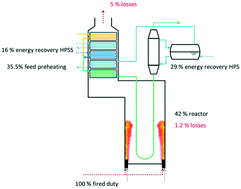当前位置:
X-MOL 学术
›
React. Chem. Eng.
›
论文详情
Our official English website, www.x-mol.net, welcomes your
feedback! (Note: you will need to create a separate account there.)
Sustainable innovations in steam cracking: CO2 neutral olefin production
Reaction Chemistry & Engineering ( IF 3.4 ) Pub Date : 2019/12/19 , DOI: 10.1039/c9re00398c Ismaël Amghizar 1, 2, 3, 4 , Jens N. Dedeyne 1, 2, 3, 4 , David J. Brown 4, 5, 6 , Guy B. Marin 1, 2, 3, 4 , Kevin M. Van Geem 1, 2, 3, 4
Reaction Chemistry & Engineering ( IF 3.4 ) Pub Date : 2019/12/19 , DOI: 10.1039/c9re00398c Ismaël Amghizar 1, 2, 3, 4 , Jens N. Dedeyne 1, 2, 3, 4 , David J. Brown 4, 5, 6 , Guy B. Marin 1, 2, 3, 4 , Kevin M. Van Geem 1, 2, 3, 4
Affiliation

|
Steam cracking of hydrocarbons is and will continue to be the main industrial process to produce light olefins in the coming decades. In state of the art steam cracking plants more than 90% of the CO2 emissions can be directly related to the high energy consumption of the endothermic conversion in the cracking furnaces. Steam cracking accounts for a global emission of more than to 300 million tonnes of CO2per annum. Enhancing heat transfer in the radiation section, using green energy and reducing coke formation are key to substantially reduce CO2 emissions. Heat transfer can be increased by implementing three-dimensional (3D) coil technologies such as swirled and dimpled tubes. These reactor technologies also reduces coke formation because of the lower wall temperatures that are consequently obtained. Advanced manufacturing techniques and better computational abilities have opened the door to novel and improved 3D reactor technologies that are designed to increase the heat transfer while minimizing the pressure drop penalty. At the same time applying high emissivity coatings on the furnace refractory and reactor tubes can further reduce CO2 emissions. Substantial fuel savings can also be obtained by a novel furnace design, where the heat recovery scheme is substantially modified. Combining all these technologies could result in reducing emissions by 30%. Shifting completely to green electricity, which is practically infeasible today, is another alternative but the technologies that would potentially allow this are still in their infancy. These new technologies, combined with advanced process innovations and CO2 capture, will help the industry to meet future emissions targets.
中文翻译:

蒸汽裂化的可持续创新:二氧化碳中性烯烃的生产
在未来几十年中,碳氢化合物的蒸汽裂化将继续并将继续是生产轻质烯烃的主要工业过程。在现有技术的蒸汽裂化装置中,超过90%的CO 2排放量可能直接与裂化炉中吸热转化的高能耗有关。蒸汽的超过300万公吨二氧化碳的全球排放开裂账户2年息。使用绿色能源提高辐射部分的传热效率并减少焦炭形成,是大幅减少CO 2的关键排放。可以通过实施三维(3D)盘管技术(例如涡流管和凹坑管)来增加热传递。这些反应器技术还由于降低了壁温而减少了焦炭的形成。先进的制造技术和更好的计算能力为新颖和改进的3D反应器技术打开了大门,这些技术旨在增加热传递,同时最大程度地降低压降损失。同时在高炉耐火材料和反应器管上涂覆高发射率涂层可以进一步减少CO 2。排放。通过新颖的熔炉设计,还可以大大节省燃料,在该设计中,对热回收方案进行了重大修改。结合所有这些技术可以减少30%的排放。完全转向绿色电力(在当今几乎是不可行的)是另一种选择,但可能允许这种能源发展的技术仍处于起步阶段。这些新技术与先进的工艺创新和CO 2捕集相结合,将有助于行业实现未来的排放目标。
更新日期:2020-02-13
中文翻译:

蒸汽裂化的可持续创新:二氧化碳中性烯烃的生产
在未来几十年中,碳氢化合物的蒸汽裂化将继续并将继续是生产轻质烯烃的主要工业过程。在现有技术的蒸汽裂化装置中,超过90%的CO 2排放量可能直接与裂化炉中吸热转化的高能耗有关。蒸汽的超过300万公吨二氧化碳的全球排放开裂账户2年息。使用绿色能源提高辐射部分的传热效率并减少焦炭形成,是大幅减少CO 2的关键排放。可以通过实施三维(3D)盘管技术(例如涡流管和凹坑管)来增加热传递。这些反应器技术还由于降低了壁温而减少了焦炭的形成。先进的制造技术和更好的计算能力为新颖和改进的3D反应器技术打开了大门,这些技术旨在增加热传递,同时最大程度地降低压降损失。同时在高炉耐火材料和反应器管上涂覆高发射率涂层可以进一步减少CO 2。排放。通过新颖的熔炉设计,还可以大大节省燃料,在该设计中,对热回收方案进行了重大修改。结合所有这些技术可以减少30%的排放。完全转向绿色电力(在当今几乎是不可行的)是另一种选择,但可能允许这种能源发展的技术仍处于起步阶段。这些新技术与先进的工艺创新和CO 2捕集相结合,将有助于行业实现未来的排放目标。











































 京公网安备 11010802027423号
京公网安备 11010802027423号